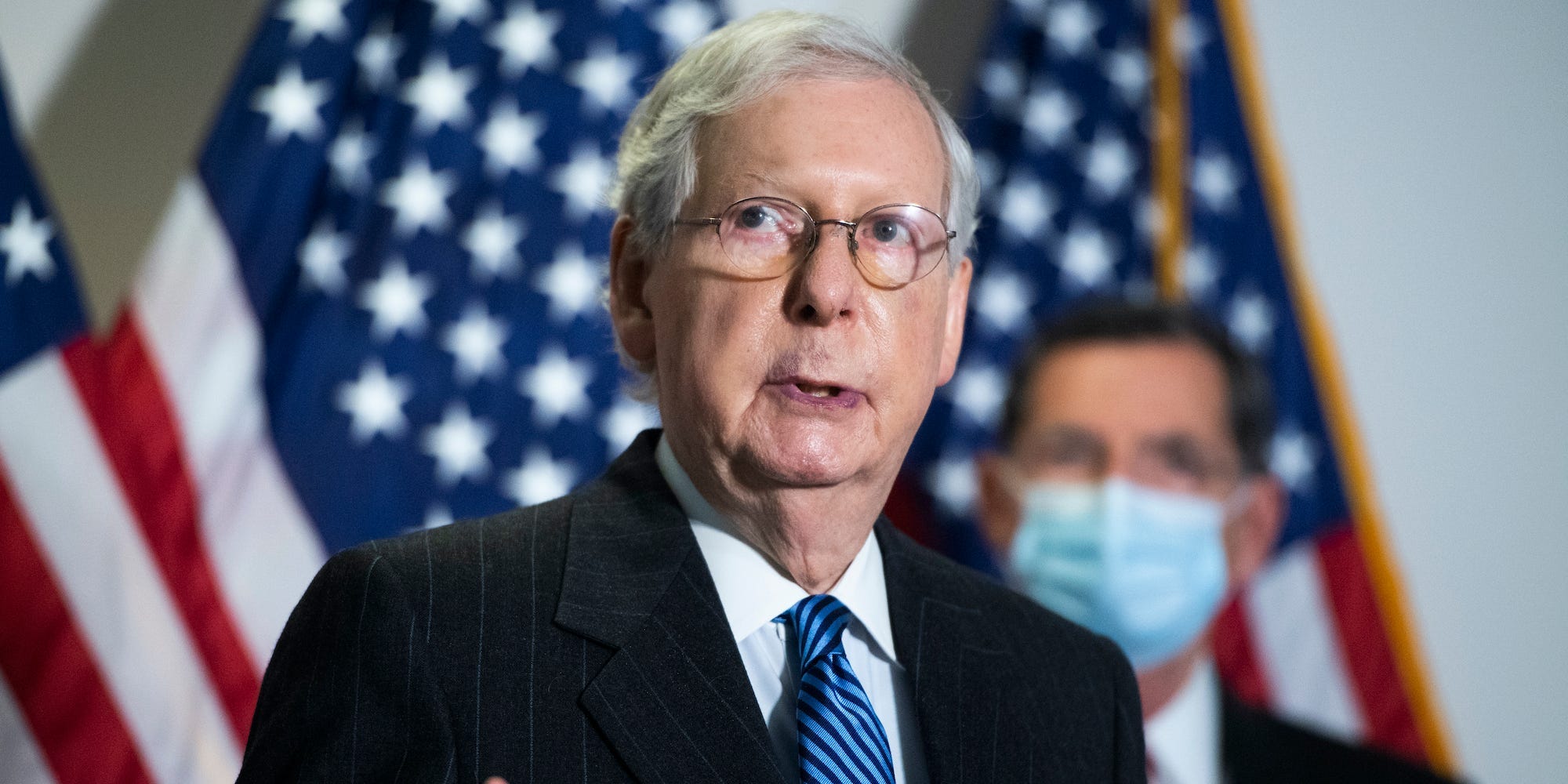
Photo By Tom Williams/CQ-Roll Call, Inc via Getty Images/
- McConnell wanted a promise that Democrats would not eliminate the filibuster.
- Two Democratic Senators signaled their support for keeping the filibuster in place Monday.
- With those assurances, McConnell said he was ready to move forward with an organizing resolution.
- Visit Insider’s homepage for more stories.
Senate Minority Leader Mitch McConnell said Monday night that he would move forward with organizing the new Senate after days of a forced stalemate over the filibuster.
Before allowing the new Democrat-controlled Senate to begin work, McConnell wanted a promise that Democrats would not eliminate the filibuster.
It appears McConnell got his wish.
Two Democratic Senators, Sen. Joe Manchin of West Virginia and Sen. Kyrsten Sinema of Arizona, both signaled their support Monday for keeping the filibuster in place, effectively eliminating any possibility that Democrats could scrap the procedure.
Senate Majority Leader Chuck Schumer responded to McConnell’s statement Monday night, saying he was looking forward to organizing the Senate under Democratic control and starting to get things done for the American people.
"We're glad Senator McConnell threw in the towel and gave up on his ridiculous demand," Schumer's spokesperson, Justin Goodman, reportedly said.
A filibuster offers the minority party a chance to block legislative action
The filibuster is a prolonged debate commonly used by members of the minority party to prevent measures from being brought to a vote and blocking legislative action. A filibuster can be ended if the Senate reaches cloture, in which 60 out of 100 members agree to end the debate.
The rules of filibusters require that a senator must remain standing the entire time they are speaking. They cannot take restroom breaks, can only drink water or milk, and cannot eat anything. If they yield or break these rules, the Senate can move on to the next order of business, ending the filibuster. Senators have been known to bring in guest speakers and props to help their case.
Former South Carolina Senator Strom Thurmond filibustered for 24 hours and 18 minutes - the longest filibuster in history - against the Civil Rights Act of 1957. Perhaps one of the most well-known filibusters in modern history was that of Texas state Sen. Wendy Davis, who filibustered for 13 hours to prevent a vote on an abortion omnibus bill.
In 2013, a Democratic-majority Senate voted to prohibit the use of the filibuster when debating executive branch nominations and federal judicial appointments. In 2017, under Senate Majority Leader Mitch McConnell, the Senate extended that rule to Supreme Court nominations so they could confirm Trump pick Neil Gorsuch to replace Antonin Scalia. The lack of filibuster on Supreme Court nominations became an issue again when the Senate pushed through the confirmation of Amy Coney Barrett in the weeks prior to the 2020 presidential election.
Members of both parties have called for filibuster reform in the past few years, citing partisan gridlock, and it became a topic of debate during the 2020 presidential primaries.
McConnell forced a confrontation by refusing to move forward with an organizational resolution for the Senate until Dems promised not to eliminate the filibuster
At the start of each new Congress, the Senate adopts a new organizing resolution, a structural framework that lists committee ratios, committee memberships, and other agreements between the parties. The resolution is usually a routine matter, approved by a unanimous consent agreement. However, when the Senate has been closely divided, the organizing resolution has sparked disagreement among party leaders.
With the narrow majority Democrats now hold in the Senate, a 50-50 tie with Vice President Kamala Harris serving as the tie-breaking vote, Senate leaders found themselves in such a predicament.
McConnell forced a confrontation by refusing to move forward with an organizational resolution until Democrats promised not to eliminate the filibuster with their simple majority - a move that is commonly referred to as the "nuclear option." Schumer refused to acquiesce. Many Democrats wanted to at least retain the possibility of threatening the filibuster in the future, instead of bowing to McConnell's demands now.
But Manchin and Sinema's emphatic objections to gutting the filibuster means the "nuclear option" is unlikely, and for now, McConnell seems confident the rule will remain safe. In his statement Monday night, he said he felt assured enough to move forward with the 50-50 power-sharing agreement.
What does this mean moving forward?
With the filibuster safe for now, it's unlikely any sweeping legislation can be passed, as the gridlocked chamber would need all members of the Democratic Caucus plus an additional ten Republicans to do so.
Calls for filibuster reform seem to be ramping up, and it's possible that shifting public opinion on the rule may keep the debate alive moving forward.
Eradicating the filibuster would significantly change the way the Senate operates. The majority party would gain immeasurable legislative power while the minority party would lose its most powerful tool of obstruction.
"Democrats used it constantly, as they had every right to," McConnell said on the floor last week. "They were happy to insist on a 60-vote threshold for practically every measure or bill I took up."
With the shifting nature of American politics, many lawmakers see the filibuster as too crucial a tool for forcing bipartisan compromise to give it up, even if they hold the majority.
But as Biden works to implement his agenda, Democrats will likely continue to face mounting pressure from advocates and activists to eliminate the filibuster altogether.